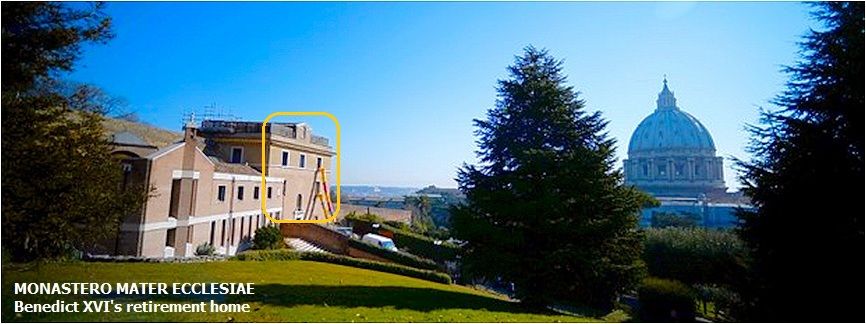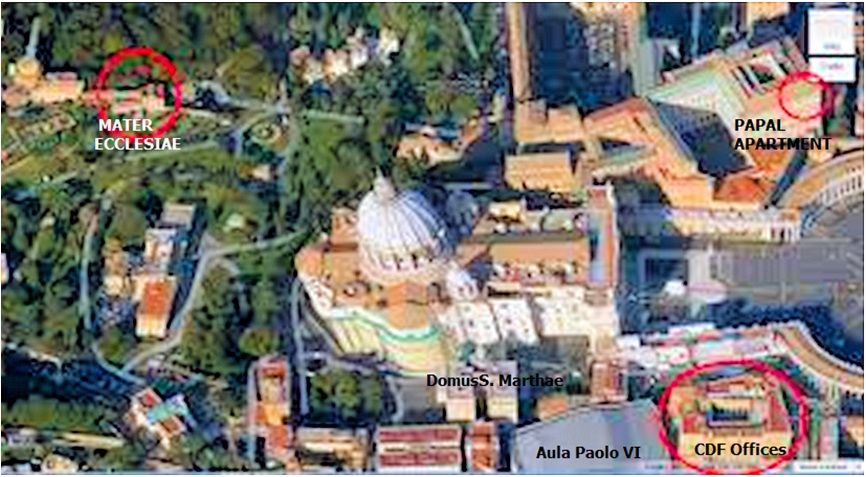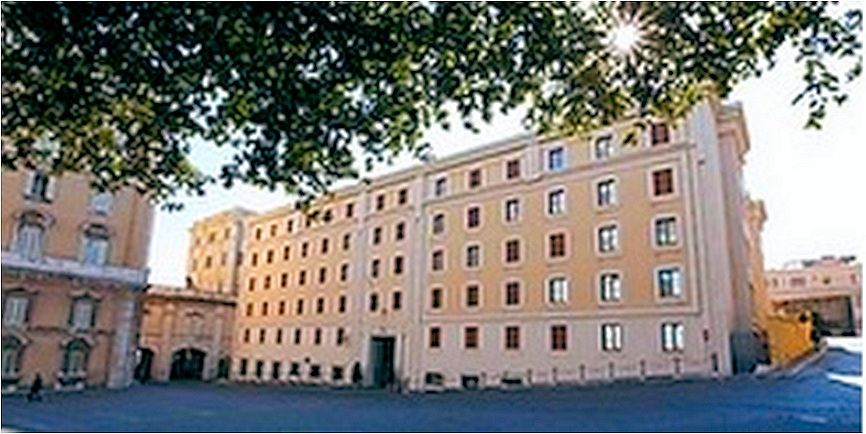 The Pope retires...
The Pope retires...
to a monastery
After two months in Castel Gandolfo immediately following the end of his Pontificate, Benedict XVI will be living in what was once the residence of the cloistered nuns requested by John Paul II to pray especially for the Church and the Pope.
[Various orders alternated for 3-5 year terms, and the last order left last November.]

The world of Joseph Ratzinger since February 1982: Corbinian's bear will end up, not roaming his native forest, but in the quiet peace of the Vatican gardens, still "the Lord's donkey, just the way for me to remain wholly yours and always abide with you".
Yesterday, newsmen covering the Vatican were shown the exterior of the premises by Benedikt Steinschulte, an official from the Pontifical Council for Social Communications, who also showed them the Domus Sanctae Marthae, the Vatican's hotel for visiting prelates, built in the late 1990s on orders of John Paul II to provide accommodations for cardinals taking part in Conclave.
Earlier, CNA filed this story from Madrid, in which a nun who lived at the Mater Ecclesiae monastery recounts some details about the place.
A nun recalls the simplicity
of the Mater Ecclesiae residence

Madrid, Spain, Feb 14, 2013 (CNA/EWTN News)- One of the nuns who lived in the monastery where the Pope will retire says his choice shows his “great simplicity” because it “is not a work of art or comparable with other Vatican buildings.”
“His decision to retire has surprised me, but he is very brave, although he is fragile and elderly,” said the nun from the Order of the Visitation of Holy Mary, who requested anonymity because of her cloistered life.
“But this decision is proof that he has a very lucid mind,” she stated, adding that “our self love does not allow us to see our own limitations, contrary to what Pope Benedict has done.”
“If I loved him before,” she declared, “now I love him even more.”
The sisters led a simple life with no staff. They spent their time praying and, for their 400th anniversary, made liturgical vestments for Pope Benedict to donate to poorer churches.
“One week before we left he asked us: ‘What will the Pope do without you?’ and he asked us to keep praying for him,” said the nun.
“His decision has made us cry, but he has been very brave,” she added.
The monastery, called Mater Ecclesiae, is 4,300 square feet and lies just west of St. Peter’s Basilica.
Adjoining the residence of the nuns is the wing that has a chapel, a choir room, a library, a semi-basement, a terrace and a visiting room that was added in 1993.
When Pope Benedict XVI announced on Feb. 11 that he was going to resign from the papacy and live in the convent, speculation began to circulate about when he made his decision, since renovations began in Nov. 2012.
According to the Spanish nun, who currently resides in a convent in Madrid, the building had not been refurbished in 18 years and needed minor repairs.
“We had humidity in the basement, the windows needed changing, and the terrace on top needed fixing and painting because of past snow,” she explained.
“But the building is very small, so they had to wait for us to leave to begin working on it.”
Reflecting on her experience living in the Vatican convent, the Visitation nun said she and her fellow religious felt intensely that they “were the heart of the Church.”
“It was an experience that is very hard to put into words.”
Their mission was to pray for the Pope, for his trips, and accompany him in prayer on a daily basis.
The Spanish nun recalled how Pope Benedict would often thank them for their prayers and regularly checked up on their general well-being.
He originally wanted French nuns to live in the monastery, she explained, but due to the small number of vocations in France, he decided it would be better to pick them from Spain.
The monastery was established in 1994 by Blessed John Paul II as a place dedicated solely to prayer for the Pope, his ministry and the cardinals.
The order of the Visitation of St. Mary was picked from among many other religious groups to live in the monastery from Oct. 7, 2009 until Oct. 7, 2012.
Their stay was extended for 15 days and they left the monastery on Oct. 22, just after Bl. John Paul’s feast day.
The seven sisters all came from convents in Spain, but one was from Colombia and another from Equatorial Guinea.
Robert Moynihan adds some details about the Domus Sanctae Marthae:

 I wonder if there's a little plaque marking the room occupied by Cardinal Ratzinger during the Conclave and before he moved to the Papal apartment...
I wonder if there's a little plaque marking the room occupied by Cardinal Ratzinger during the Conclave and before he moved to the Papal apartment...
...The Domus Sanctae Marthae, where the cardinals will sleep and eat during the conclave, was built in the 1990s by Pope John Paul II to provide an alternative to the close, cramped quarters cardinal-electors had formerly used inside the Apostolic Palace itself.
“There was only one lavatory for every 10 cardinals in the Apostolic Palace, and no doors on the showers,” said our guide Steinschulte.
For this Conclave, as for the one in 2005 (the first time the Domus was used by cardinal-electors), the cardinals will be escorted from the Domus to the Sistine Chapel, where the voting will take place.
The able-bodied will walk -- the walk takes about seven minutes -- while older cardinals will be transported by mini-bus.
The road behind the basilica will be closed to all pedestrians and traffic to ensure that the electors remain in total seclusion from the outside world.
The Domus and the Sistine Chapel will be swept for bugs and other listening devices before the Conclave begins.
“They can’t talk to anybody, they can’t use their mobile phones – they are totally closed off,” said Steinschulte, a powerfully-built German who is close to Pope Benedict and has worked in the Vatican for nearly 30 years. “After all, the word conclave comes from ‘cum clave’ – "with a key," meaning locked in with a key.”
The Domus has 108 suites and 23 single rooms, all with private bathrooms – a great improvement on the accommodation endured by cardinals during past conclaves.
Vatican City has a permanent population of about 500, including cardinals, bishops and the 150 members of the Swiss Guard.
The Vatican also has said that Benedict will send his last Tweet on February 28, his final day in office, and after that his Twitter handle, @pontifex, will fall silent. It will be up to the new Pope to decide whether he wishes to revive a papal account.
It is not clear whether the Vatican Gardens will be "off limits" to visitors in the years to come. Up until now, it has been possible for visitors to walk in the gardens after requesting a special pass, which was readily granted.
[Modificato da TERESA BENEDETTA 21/02/2013 20:23]